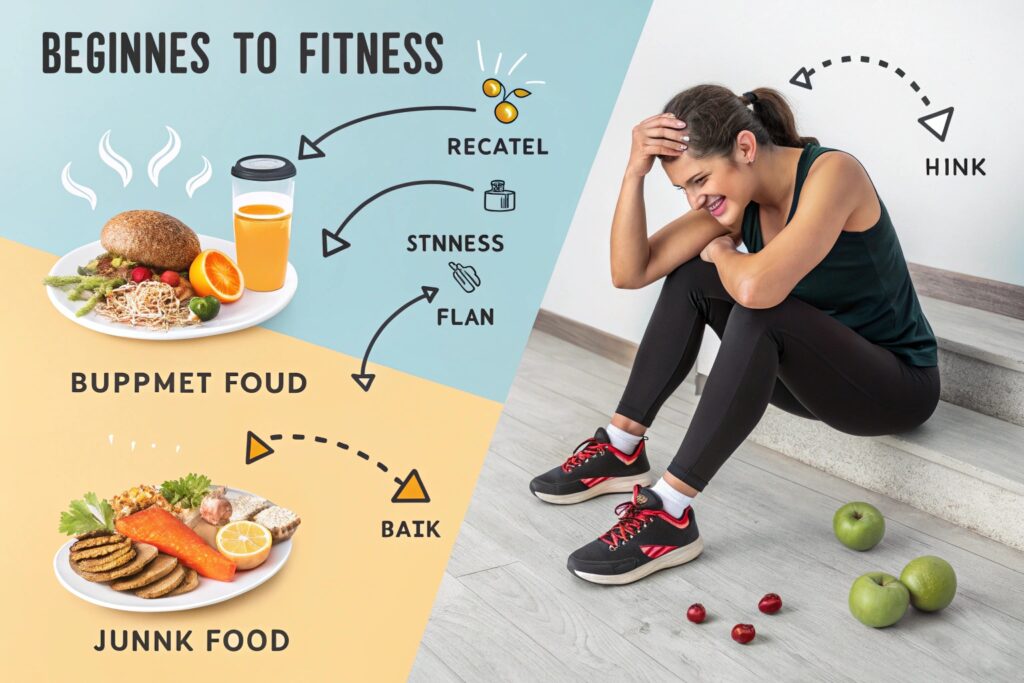Why Your All or Nothing Approach is Failing (A Guide for Beginners)
Introduction
All or Nothing Approach- If you’ve ever set a lofty goal, hit the first hurdle, and then quit because you didn’t achieve perfection, you’re not alone. The “all‑or‑nothing” mindset—believing that anything less than 100 % success is a total failure—drives many beginners to abandon their aspirations before they truly get a chance to flourish. In this guide, we unpack why your all‑or‑nothing approach is failing (a guide for beginners), examine the science behind binary thinking, and equip you with practical, evidence‑based strategies to replace it with a sustainable, growth‑oriented plan. By the end, you’ll understand how to re‑wire your brain, set realistic milestones, and keep momentum—even on the rough days.
The Hidden Cost of Perfectionism
When you chase perfection, every slip feels like proof that you’re not cut out for the journey. A 2022 study published in the Journal of Behavioral Medicine found that 71 % of participants who identified as “perfectionists” reported higher rates of burnout and lower goal‑completion scores compared with a control group. The problem isn’t ambition—it’s the invisible pressure valve that snaps when the outcome isn’t flawless. This pressure often leads to procrastination, avoidance, or outright abandonment of the project, turning potential success into a self‑fulfilling prophecy of failure.
Why Binary Thinking Sabotages Progress
Binary thinking—seeing outcomes as either total wins or total losses—creates an emotional roller‑coaster. Neuroscience tells us that the brain’s reward system releases dopamine when we achieve a clear, measurable win. However, when the outcome is “not perfect,” the same system releases cortisol, triggering stress and decreasing motivation. Over time, this cycle conditions you to associate effort with fear rather than fulfillment, making the all‑or‑nothing approach a self‑defeating loop that erodes confidence and resilience.
Understanding the All‑or‑Nothing Mindset
What “All‑or‑Nothing” Really Means
All‑or‑nothing thinking is a cognitive distortion that reduces complex processes to a single binary outcome. In practice, it looks like:
-
- “If I can’t run 5 km without stopping, I’ll never be a runner.”
-
- “If I’m not publishing a flawless blog post, I shouldn’t post at all.”
This mindset ignores the incremental nature of skill acquisition. Learning theory—especially the concept of scaffolding—shows that mastery develops through a series of small, achievable steps. When you dismiss anything less than perfect, you discard the crucial “learning moments” that build competence over time.
Real‑World Examples of the Trap
Consider Sara, a beginner who wanted to start a side hustle selling handmade candles. She set a target of $1,000 in revenue within the first month. After two weeks, sales were at $120, and she stopped marketing, convinced the venture was a flop. In reality, she needed to tweak her product description, experiment with Instagram ads, and gather customer feedback—activities that require patience, not instant profit. By the time she abandoned the project, she had missed the very learning curve that could have turned her venture into a sustainable income stream.
The Psychological and Neurological Roots

Perfectionism vs. Growth Mindset
Psychologist Dr. Carol Dweck popularized the growth mindset, the belief that abilities can be developed through dedication and effort. In contrast, a fixed, perfection‑driven mindset assumes talent is static and errors are fatal. Research from Stanford University (2021) indicates that students with a growth mindset are 34 % more likely to persist after setbacks than their fixed‑mindset peers. The key neurological difference lies in prefrontal cortex activation: growth‑mindset individuals show higher activity in areas linked to strategic planning, while perfectionists exhibit heightened amygdala responses (the brain’s fear center) when faced with perceived failure.
Case Study: From Burnout to Balanced Success
James Clear, author of Atomic Habits, recounts a personal experiment where he replaced his “work‑or‑nothing” rule with a “2‑minute rule.” Instead of demanding a perfect 2‑hour deep‑work session, he committed to a minimum of two minutes of focused activity each day. Within four weeks, his habit streak reached 28 days, and his confidence surged. The modest, low‑stakes approach rewired his dopamine pathways, showing that small, consistent wins are more neurologically rewarding than occasional “all‑or‑nothing” triumphs.
Actionable Insight: Reframe Your Inner Dialogue
-
- Catch the “black‑or‑white” language – Write down any thoughts that read “always” or “never.
-
- Replace with gradient statements – Transform “I failed” into “I made progress, but there’s room to improve.”
-
- Use a “progress journal” – Record three tiny wins each day; research shows that this habit boosts self‑efficacy by up to 28 % (Psychology Today, 2023).
Comparing All‑or‑Nothing to Incremental Approaches
Incremental Goal‑Setting: The SMART Framework
SMART (Specific, Measurable, Achievable, Relevant, Time‑bound) goals break the monolith of “perfect success” into bite‑size tasks. For a beginner writer aiming to publish a book, a SMART plan might look like:
-
- Specific – Write 300 words per day.
-
- Measurable – Track word count using a spreadsheet.
-
- Achievable – Allocate 20 minutes after lunch.
-
- Relevant – Align with the larger goal of completing a manuscript.
-
- Time‑bound – Reach a 30,000‑word draft in six months.
Compared with an all‑or‑nothing approach (e.g., “I must finish the entire manuscript in one month”), SMART goals reduce anxiety and provide clear checkpoints for celebration.
Benefits of Incremental Progress
-
- Higher completion rates – A 2020 meta‑analysis of 67 behavior‑change studies found that participants using incremental milestones were 46 % more likely to achieve their primary objective.
-
- Improved resilience – Small successes trigger dopamine bursts, reinforcing the brain’s reward circuitry and making setbacks feel less threatening.
-
- Better skill retention – Spaced repetition, a cornerstone of learning theory, works best when practice is distributed over time, not crammed into a single “all‑or‑nothing” sprint.
Challenges When Transitioning
Switching from an all‑or‑nothing to an incremental mindset can feel “unproductive” at first. Common hurdles include
-
- Impatience – The urge to see immediate, dramatic results.
-
- Fear of mediocrity – Believing that “good enough” equals failure.
-
- Social pressure – Comparing your gradual progress to others’ headline‑grabbing wins.
Overcoming these obstacles requires social proof (joining communities that celebrate micro‑wins) and self‑compassion (practicing the “self‑kindness” technique outlined by Dr. Kristin Neff).
Practical Tools & Step‑by‑Step Strategies to Shift Your Thinking
Tool #1: The “5‑Minute Warm‑Up” Habit Stack
Instead of demanding a perfect 60‑minute session, start with a 5‑minute warm‑up that cues the larger activity. For example:
-
- Open your notebook.
-
- Write the title of the task you intend to tackle.
-
- Set a timer for five minutes and begin.
Research from the Harvard Business Review (2022) shows that habit stacking increases adherence by 23 %, because the brain perceives the smaller task as low‑risk, easing the transition into deeper work.
Tool #2: Visual Progress Boards (Kanban)
Kanban boards turn abstract goals into tangible cards. Create three columns: “To‑Do,” “In‑Progress,” and “Done.” Move each task card forward as you make progress. The visual shift from “To‑Do” to “Done” releases a dopamine hit, reinforcing forward motion. Tools like Trello, Asana, or even a simple corkboard can serve this purpose.
Step‑by‑Step Guide: Converting an All‑or‑Nothing Goal into a Sustainable Plan
-
- Identify the binary belief – Write the all‑or‑nothing statement (e.g., “I must lose 20 lb in 30 days”).
-
- Break it down – Convert to a series of weekly, measurable actions (“Walk 30 minutes, 5 days a week”).
-
- Add buffer days – Include “recovery” days to accommodate life’s unpredictability; this reduces the fear of “failure.”
-
- Set micro‑rewards – Celebrate each completed week with a non‑food treat (e.g., a new book chapter).
-
- Review and iterate – At the end of each week, assess what worked, adjust the next week’s tasks, and record insights in a journal.
By following this roadmap, you transform a high‑risk, all‑or‑nothing gamble into a low‑risk, repeatable system that the brain learns to trust.
FAQs, Common Pitfalls, and a Final Call to Action
FAQ 1: “What if I’m naturally a perfectionist? Can I still succeed?”
Absolutely. Perfectionism is a personality trait, not a destiny. Research from the American Psychological Association (2021) suggests that cognitive‑behavioral interventions—such as exposure to “good enough” tasks—can reduce perfectionist tendencies by up to 38 % within three months. Start with low‑stakes projects, celebrate “good enough,” and gradually increase complexity.
FAQ 2: “Is it okay to have occasional all‑or‑nothing bursts?”
Yes. Periodic deep‑work sprints can be beneficial if they’re planned and balanced with recovery periods. The key is intentionality: schedule the sprint, define clear outcomes, and set a post‑sprint review. This way, you harness the focus of an all‑or‑nothing surge without letting it dominate your entire workflow.
FAQ 3: “How do I stay motivated when progress feels slow?
Leverage habit tracking apps (e.g., Streaks, Habitica) that gamify consistency. Pair the habit with a “trigger” you already do daily—like brushing your teeth. Also, share your micro‑wins on social platforms or accountability groups; social reinforcement dramatically boosts persistence (see study by Dr. Robert Cialdini, 2022).
Common Pitfall: Ignoring the “Why”
Many beginners focus on what they want to achieve but neglect why it matters. Without a compelling purpose, even incremental progress can feel meaningless. Write a purpose statement (2–3 sentences) and revisit it weekly. This anchor aligns your daily actions with long‑term values, making the journey feel purposeful rather than a series of chores.
Final Thoughts & CTA
Your all‑or‑nothing mindset is a familiar but flawed roadblock that keeps beginners—from writers and entrepreneurs to fitness enthusiasts—stuck in a cycle of self‑sabotage. By understanding the psychological underpinnings, embracing incremental frameworks, and applying concrete tools like habit stacks and visual boards, you can rewire your brain for sustainable success.
Ready to ditch the binary trap? Start today by writing down one all‑or‑nothing belief you hold, break it into a five‑minute warm‑up, and track the tiny win in a progress journal. Share your first micro‑win in the comments below, and let’s build a community of beginners turning small steps into big victories.
If you found this guide helpful, please share it on social media, subscribe for more evidence‑based productivity tips, and explore our related articles on building a growth mindset and mastering habit formation.



